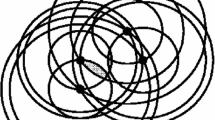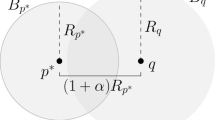Abstract
Two questions concerning the location of a single facility by a voting process are investigated for transportation networks:
-
- What is the maximum number of customers located on the network preferring some rival point over a voting solution?
-
- How does the average distance of the customers to the facility increase when a voting location instead of a Weber location is chosen for the facility?
Complete answers are given for general networks and for certain planar networks, viz., the so-called generalized cacti.
Similar content being viewed by others
References
Bandelt H-J (1985) Networks with Condorcet solutions. Eur J Oper Res 20: 314–326
Greenberg J (1979) Consistent, majority rules over compact sets of alternatives. Econometrica 47: 627–636
Greenberg J, Weber Sh (1984) Balancedness, nonemptiness of the core and the existence of a majority equilibrium. Int J Game Theory 13: 65–68
Hakimi SL (1964) Optimum locations of switching centers and the absolute centers and medians of a graph. Oper Res 12: 450–459
Hakimi SL (1983) On locating new facilities in a competitive environment. Eur J Oper Res 12: 29–35
Hansen P, Labbé M (1986) Algorithms for voting and competitive location on a network. Submitted
Hansen P, Thisse J-F (1981) Outcomes of voting and planning: Condorcet, Weber and Rawls locations. J Public Econ 16: 1–15
Hansen P, Thisse J-F, Wendell RE (1986a) Equivalence of solutions to network location problems. Math Oper Res
Hansen P, Thisse J-F, Wendell RE (1986b) Location by competitive and voting processes. In: Francis RL, Mirchandani PB (eds) Discrete location theory. Wiley, New York
Labbé M (1983) Solution de Condorcet et mediane dans le réseaux simples. Cah Cent Etud Rech Oper 25: 217–229
Labbé M (1985) Outcomes of voting and planning in single faclity location problems. Eur J Oper Res 20: 299–313
Simpson P (1969) On defining areas of voter choice: Professor Tullock on stable voting. Q J Econ 83: 478–490
Slater PJ (1975) Maximin facility location. J Res Natl Stand 79B: 107–115
Wendell RE, McKelvey RD (1981) New perspectives, in competitive location theory. Eur J Oper Res 6: 174–182
Wendell RE, Thorson SJ (1974) Some generalizations of social decisions under majority rule. Econometrica 42: 893–912
Author information
Authors and Affiliations
Additional information
This research was carried out during the First EURO Summer Institute on Location Theory held at Brussels, 1984. The paper benefitted from stimulating discussions with Pierre Hansen. The research of the second author was supported by the Action de Recherche Concertée of the Belgian Government under contract 84/8965.
Rights and permissions
About this article
Cite this article
Bandelt, H.J., Labbé, M. How bad can a voting location be. Soc Choice Welfare 3, 125–145 (1986). https://doi.org/10.1007/BF00435663
Received:
Accepted:
Issue Date:
DOI: https://doi.org/10.1007/BF00435663




